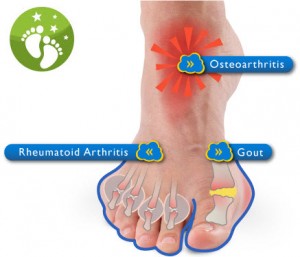Patients who undergo surgery to correct arthritis in the foot are often diabetics with a type of arthritis known as Charcot Foot. The average age of patients developing a Charcot foot is 40 years. About one-third of patients develop a Charcot foot in both feet and/or ankles. This form of arthritis can develop suddenly and without pain. Quite suddenly, the bones in the foot and/or ankle can spontaneously fracture and fragment, often causing a severe deformity.
The arch of the foot often collapses, and pressure areas develop on the bottom of the foot, leading to open sores or ulcers.
While many of these deformities can be treated with nonsurgical care, surgery for arthritis may be required. Such instances may include:
- Chronic deformity with increased plantar pressures and risk of ulcers.
- Chronic deformity with significant instability that cannot be corrected by braces.
- Significant deformity that may include ulcers that don’t heal or respond to therapy.
Surgical procedures used to treat arthritis include:
- Hindfoot and ankle realignment. This kind of procedure is usually prescribed when there is significant instability resulting in a patient being unable to walk. Various types of internal fixation are placed within the foot during this kind of procedures.
- Midfoot realignment. This kind of procedure is usually prescribed when there is significant instability of the middle portion of the foot. During a midfoot realignment, various types of internal fixation are placed within the foot.
- Ostectomy. In this procedure, a portion of bone is removed from the bottom of the foot. It is usually performed for a wound on the bottom of the foot that is secondary to pressure from a bony prominence.

